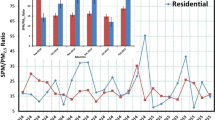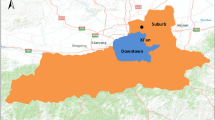Abstract
Particulate matter (PM) pollution has become a major environmental concern in many developing countries. PM pollution control remains a great challenge owing to the complex sources and evolution processes of PM particles. There are two categories of PM, i.e., primary and secondary PM particles, and the primary PM emissions play a key role in the formation of PM pollution. Knowledge of primary PM particle compositions, sources, and evolution processes is of great importance to the effective control of PM pollution. In order to characterize PM particles effectively, their fundamental properties including the morphology, concentration distribution, surface chemistry, and composition must be systematically investigated. In this study, we collected and analyzed six types of PM10 and PM2.5 particles from different sources using an in situ sampling approach. The concentration distributions of PM particles were analyzed and comparative analysis of the morphologies, distributions, capture mechanisms, and compositions of PM particles was conducted using scanning electron microscopy, transmission electron microscopy, X-ray photoelectron spectroscopy, and energy-dispersive X-ray spectroscopy. We found that there were significant differences in the structures, morphologies, and capture mechanisms of PM2.5 and PM10 particles. The systematic comparative investigation in this work will benefit the study of evolution processes and the effective control of PM pollution in the future.

Similar content being viewed by others
References
Fang, M.; Chan, C. K.; Yao, X. H. Managing air quality in a rapidly developing nation: China. Atmos. Environ. 2009, 43, 79–86.
Seinfeld, J. H. Urban air pollution: State of the science. Science 1989, 243, 745–752.
Zhang, R.; Jing, J.; Tao, J.; Hsu, S. C.; Wang, G.; Cao, J.; Lee, C. S. L.; Zhu, L.; Chen, Z.; Zhao, Y. et al. Chemical characterization and source apportionment of PM2.5 in Beijing: Seasonal perspective. Atmos. Chem. Phys. 2013, 13, 7053–7074.
Maricq, M. M. Chemical characterization of particulate emissions from diesel engines: A review. J. Aerosol Sci. 2007, 38, 1079–1118.
Makkonen, U.; Hellén, H.; Anttila, P.; Ferm, M. Size distribution and chemical composition of airborne particles in south-eastern Finland during different seasons and wildfire episodes in 2006. Sci. Total Environ. 2010, 408, 644–651.
Betha, R.; Behera, S. N.; Balasubramanian, R. 2013 Southeast Asian smoke haze: Fractionation of particulate-bound elements and associated health risk. Environ. Sci. Technol. 2014, 48, 4327–4335.
Wu, S. W.; Deng, F. R.; Wei, H. Y.; Huang, J.; Wang, X.; Hao, Y.; Zheng, C. J.; Qin, Y.; Lv, H. B.; Shima, M. et al. Association of cardiopulmonary health effects with sourceappointed ambient fine particulate in Beijing, China: A combined analysis from the healthy volunteer natural relocation (HVNR) study. Environ. Sci. Technol. 2014, 48, 3438–3448.
Brook, R. D.; Rajagopalan, S.; Pope III, C. A.; Brook, J. R.; Bhatnagar, A.; Diez-Roux, A. V.; Holguin, F.; Hong, Y. L.; Luepker, R. V.; Mittleman, M. A. et al. Particulate matter air pollution and cardiovascular disease: An update to the scientific statement from the American Heart Association. Circulation 2010, 121, 2331–2378.
Anenberg, S. C.; Horowitz, L. W.; Tong, D. Q.; West, J. J. An estimate of the global burden of anthropogenic ozone and fine particulate matter on premature human mortality using atmospheric modeling. Environ. Health Perspect. 2010, 118, 1189–1195.
Timonen, K. L.; Vanninen, E.; De Hartog, J.; Ibald-Mulli, A.; Brunekreef, B.; Gold, D. R.; Heinrich, J.; Hoek, G.; Lanki, T.; Peters, A. et al. Effects of ultrafine and fine particulate and gaseous air pollution on cardiac autonomic control in subjects with coronary artery disease: The ULTRA study. J. Expo. Sci. Environ. Epidemiol. 2006, 16, 332–341.
Zhao, S. H.; Chen, L. Q.; Li, Y. L.; Xing, Z. Y.; Du, K. Summertime spatial variations in atmospheric particulate matter and its chemical components in different functional areas of Xiamen, China. Atmosphere 2015, 6, 234–254.
Hoek, G.; Krishnan, R. M.; Beelen, R.; Peters, A.; Ostro, B.; Brunekreef, B.; Kaufman, J. D. Long-term air pollution exposure and cardio-respiratory mortality: A review. Environ. Health 2013, 12, 43.
Zhang, Y. Y.; Yuan, S.; Feng, X.; Li, H. W.; Zhou, J. W.; Wang, B. Preparation of nanofibrous metal–organic framework filters for efficient air pollution control. J. Am. Chem. Soc. 2016, 138, 5785–5788.
Zhang, R. F.; Liu, C.; Hsu, P. C.; Zhang, C. F.; Liu, N.; Zhang, J. S.; Lee, H. R.; Lu, Y. Y.; Qiu, Y. C.; Chu, S. et al. Nanofiber air filters with high-temperature stability for efficient PM2.5 removal from the pollution sources. Nano Lett. 2016, 16, 3642–3649.
Xu, J. W.; Liu, C.; Hsu, P. C.; Liu, K.; Zhang, R. F.; Liu, Y. Y.; Cui, Y. Roll-to-roll transfer of electrospun nanofiber film for high-efficiency transparent air filter. Nano Lett. 2016, 16, 1270–1275.
Wang, S.; Zhao, X. L.; Yin, X.; Yu, J. Y.; Ding, B. Electret polyvinylidene fluoride nanofibers hybridized by polytetrafluoroethylene nanoparticles for high-efficiency air filtration. ACS Appl. Mater. Interfaces 2016, 8, 23985–23994.
Liu, C.; Hsu, P. C.; Lee, H. W.; Ye, M.; Zheng, G. Y.; Liu, N.; Li, W. Y.; Cui, Y. Transparent air filter for high-efficiency PM2.5 capture. Nat. Commun. 2015, 6, 6205.
Gong, G. M.; Zhou, C.; Wu, J. T.; Jin, X.; Jiang, L. Nanofibrous adhesion: The twin of gecko adhesion. ACS Nano 2015, 9, 3721–3727.
Li, P.; Zong, Y. C.; Zhang, Y. Y.; Yang, M. M.; Zhang, R. F.; Li, S. Q.; Wei, F. In situ fabrication of depth-type hierarchical CNT/quartz fiber filters for high efficiency filtration of sub-micron aerosols and high water repellency. Nanoscale 2013, 5, 3367–3372.
Han, C. B.; Jiang, T.; Zhang, C.; Li, X. H.; Zhang, C. Y.; Cao, X.; Wang, Z. L. Removal of particulate matter emissions from a vehicle using a self-powered triboelectric filter. ACS Nano 2015, 9, 12552–12561.
Wang, C. Y.; Wu, S. Y.; Jian, M. Q.; Xie, J. R.; Xu, L. P.; Yang, X. D.; Zheng, Q. S.; Zhang, Y. Y. Silk nanofibers as high efficient and lightweight air filter. Nano Res. 2016, 9, 2590–2597.
Hildemann, L. M.; Rogge, W. F.; Cass, G. R.; Mazurek, M. A.; Simoneit, B. R. T. Contribution of primary aerosol emissions from vegetation-derived sources to fine particle concentrations in Los Angeles. J. Geophys. Res. Atmos. 1996, 101, 19541–19549.
Xing, J.; Pleim, J.; Mathur, R.; Pouliot, G.; Hogrefe, C.; Gan, C. M.; Wei, C. Historical gaseous and primary aerosol emissions in the United States from 1990 to 2010. Atmos. Chem. Phys. 2013, 13, 7531–7549.
Limbeck, A.; Kulmala, M.; Puxbaum, H. Secondary organic aerosol formation in the atmosphere via heterogeneous reaction of gaseous isoprene on acidic particles. Geophys. Res. Lett. 2003, 30, DOI: 10.1029/2003GL017738.
Schuetzle, D.; Cronn, D.; Crittenden, A. L.; Charlson, R. J. Molecular composition of secondary aerosol and its possible origin. Environ. Sci. Tech. 1975, 9, 838–845.
Huang, R. J.; Zhang, Y. L.; Bozzetti, C.; Ho, K. F.; Cao, J. J.; Han, Y. M.; Daellenbach, K. R.; Slowik, J. G.; Platt, S. M.; Canonaco, F. et al. High secondary aerosol contribution to particulate pollution during haze events in China. Nature 2014, 514, 218–222.
Wal, R. L. V.; Bryg, V. M.; Hays, M. D. XPS analysis of combustion aerosols for chemical composition, surface chemistry, and carbon chemical state. Anal. Chem. 2011, 83, 1924–1930.
Jang, M.; Czoschke, N. M.; Lee, S.; Kamens, R. M. Heterogeneous atmospheric aerosol production by acidcatalyzed particle-phase reactions. Science 2002, 298, 814–817.
Li, W. J.; Shao, L. Y.; Zhang, D. Z.; Ro, C. U.; Hu, M.; Bi, X. H.; Geng, H.; Matsuki, A.; Niu, H. Y.; Chen, J. M. A review of single aerosol particle studies in the atmosphere of East Asia: Morphology, mixing state, source, and heterogeneous reactions. J. Cleaner Prod. 2015, 112, 1330–1349.
Wang, J.; Hu, Z. M.; Chen, Y. Y.; Chen, Z. L.; Xu, S. Y. Contamination characteristics and possible sources of PM10 and PM2.5 in different functional areas of Shanghai, China. Atmos. Environ. 2013, 68, 221–229.
Pope III, C. A.; Dockery, D. W.; Spengler, J. D.; Raizenne, M. E. Respiratory health and PM10 pollution: A daily time series analysis. Am. Rev. Respir. Dis. 1991, 144, 668–674.
Pope III, C. A.; Schwartz, J.; Ransom, M. R. Daily mortality and PM10 pollution in Utah Valley. Arch. Environ. Health 1992, 47, 211–217.
Pope III, C. A.; Dockery, D. W. Acute health effects of PM10 pollution on symptomatic and asymptomatic children. Am. Rev. Respir. Dis. 1992, 145, 1123–1128.
Ostro, B. D.; Hurley, S.; Lipsett, M. J. Air pollution and daily mortality in the Coachella Valley, California: A study of PM10 dominated by coarse particles. Environ. Res. 1999, 81, 231–238.
Yue, W. S.; Li, X. L.; Liu, J. F.; Li, Y.; Yu, X. H.; Deng, B.; Wan, T. M.; Zhang, G. L.; Huang, Y. Y.; He, W. et al. Characterization of PM2.5 in the ambient air of Shanghai city by analyzing individual particles. Sci. Total Environ. 2006, 368, 916–925.
Labrada-Delgado, G.; Aragon-Pina, A.; Campos-Ramos, A.; Castro-Romero, T.; Amador-Munoz, O.; Villalobos-Pietrini, R. Chemical and morphological characterization of PM2.5 collected during MILAGRO campaign using scanning electron microscopy. Atmos. Pollut. Res. 2012, 3, 289–300.
Feng, X. D.; Dang, Z.; Huang, W. L.; Shao, L. Y.; Li, W. J. Microscopic morphology and size distribution of particles in PM2.5 of Guangzhou City. J. Atmos. Chem. 2009, 64, 37–51.
Longhin, E.; Holme, J. A.; Gutzkow, K. B.; Arlt, V. M.; Kucab, J. E.; Camatini, M.; Gualtieri, M. Cell cycle alterations induced by urban PM2.5 in bronchial epithelial cells: Characterization of the process and possible mechanisms involved. Part. Fibre Toxicol. 2013, 10, 63.
Deng, X. B.; Zhang, F.; Rui, W.; Long, F.; Wang, L. J.; Feng, Z. H.; Chen, D. L.; Ding, W. J. PM2.5-induced oxidative stress triggers autophagy in human lung epithelial A549 cells. Toxicol. Vitro 2013, 27, 1762–1770.
Hueglin, C.; Gehrig, R.; Baltensperger, U.; Gysel, M.; Monn, C.; Vonmont, H. Chemical characterisation of PM2.5, PM10 and coarse particles at urban, near-city and rural sites in Switzerland. Atmos. Environ. 2005, 39, 637–651.
Lin, T. C.; Krishnaswamy, G.; Chi, D. S. Incense smoke: clinical, structural and molecular effects on airway disease. Clin. Mol. Allergy 2008, 6, 3.
Acknowledgements
We thank Dr. Yuanqing Li for fruitful discussions.
Author information
Authors and Affiliations
Corresponding author
Electronic supplementary material
Rights and permissions
About this article
Cite this article
Zhang, R., Liu, C., Zhou, G. et al. Morphology and property investigation of primary particulate matter particles from different sources. Nano Res. 11, 3182–3192 (2018). https://doi.org/10.1007/s12274-017-1724-y
Received:
Revised:
Accepted:
Published:
Issue Date:
DOI: https://doi.org/10.1007/s12274-017-1724-y




